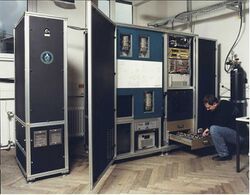Physics:Automated radioxenon sampler analyzer
From HandWiki
The automated radioxenon sampler-analyzer' (ARSA) was designed by the Pacific Northwest National Laboratory in the late 1990s with funding and support from the U.S. Department of Energy. The ARSA system automatically collects and measures radioxenon from the air.
The ARSA system continuously collects xenon from the air in batch mode, processing approximately 48 m3 in an 8-hour period. The average amount of xenon collected in this period is approximately 2 cc. The xenon gas is then transferred into nuclear detection system consisting of a beta–gamma coincidence spectrometer.
History
The ARSA was designed at PNNL in support of the International Monitoring System of the CTBT.
- 1995 – ARSA concept first proven in the laboratory
- 1997 – ARSA underwent a field test at the Environmental Measurements Laboratory in New York City
- 2000 – The ARSA system was sent to Freiburg, Germany to participate in the International Noble Gas Experiment
- 2000 – The ARSA was adopted by DME corporation for commercialization
- 2002 – The commercialization of the ARSA was transferred to General Dynamics Corporation
- 2003 – The ARSA was sent to Guangzhou, China for further participation in the International Noble Gas Experiment
Operating principles
This article does not cite any external source. HandWiki requires at least one external source. See citing external sources. (2021) (Learn how and when to remove this template message) |
 |


